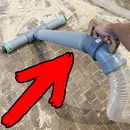Introduction: How to Replace Motorcycle Seat Cover
If you own a older motorcycle there is a good chance that the fabric of the seat is quite worn out. You know that the black duct tape is not gonna cut it anymore and you just need to get it replaced. But why not do it yourself? All you really need for it is a sewing machine and and a new fabric.
In this instructable I will demonstrate how I changed the seat cover on my Honda CB400N from 1983. I was doing a longer motorcycle tour around Europe when I just could not take the old seat cover anymore. It kept sticking to my buttocs all the time (due to the adhesieve in tape). So instead of a new layer of duct tape I desided to try and make a complete new seat cover.
Your bike will most likely not have the exact same seat design but basic principles will stay the same. Of course, the new cover will not look as good as tailor made one but what the hell!? You made yourself a seat cover - that is something not many motorcyclist can say, eh? And of course, you can make it as tough as you want it making sure it last for years and years.
I would like to point out that I am not a professional sewer - far from it! I am just a guy with a old sewing machine that I got as a birthday present from my grandmother. My main interest is woodworking but from time to time I also like to fiddle around with sewing. I do not really watch any instructional videos online, I just figure things out as I do. And that is why there might be some flaws in my work but the seat turned out quite nice in my opinion. Much better than I had expected.
Let's get started!
Step 1: Tools and Materials
For this project you will need:
- New fabric for the seat. It can anything as long as it is thick enough not too stretchy and a little water resistant. I chose brown synthetic leather.
- Double-sided tape or spray adhesieve
- Strong thread (synthetic)
Tools:
- A good sewing machine. My experience has shown that usually the old machines tend to be much better and more capable. I personally own a 70´s Singer machine but this time I used an old Pfaff machine.
- Good scissors. It really makes the difference - ecpecially with thicker materials!
- Basic sewing tools (measuring tape, tailor´s chalk, ruler, clothepins, pin needles)
- Toolkit from your motorcycle
- (Staple gun)
Step 2: Remove the Old Fabric
Start by first removing all the hardware that stops you getting to the fabric (if you have any). In my case it was a plastic cover and a passenger handle. I also removed the old duct tape that had been used to repair the old seat cover. You can see that my seat was in pretty rough shape!
Bend open the hooks that are holding the fabric in place. I had these bendable triangular thingies holding my fabric in place but it can also be stapled when the base is from plastic or wood. Either way get the fabric loose.
One you have the fabric removed cut it into pieces that can be layed flat. This way it is easier to use the old pieces as templates. Try to be as precise as possible?
Step 3: Cut the New Fabric and Start Sewing
If you used seam ripper to separate the old old pieces out you do not need to add an extra 10 mm to the the edge. If you used scissors to cut the parts, you do. This will be the overhang. It is also a good idea to copy left and right side when cutting out symmetrical shapes- this way the will infact be symettrical ;) Once you have all the pieces cut out it is time to start sewing!
This is quite time consuming part as you need to be somewhat precise if you wish to have a nice result. I reccomend to sew the parts togehter as follows. First sew 10mm from the edge so that two outer faces are facing each other. Fold it out and sew two parralel lines both around 4-5 mm from the middle. Finish it up with a zig-zag in the middle. The result should be something similar as seen in the pictures. This is a really strong joint that lays flat and also looks kinda cool. It might be a good idea to first try it out on a scrap piece though.
Take your time when fitting all the pieces together. I is not actually as straight foward as you think when using the old fabric as template. You still have to fiddle around with the sizes to get the pieces matching nicely. You should slowly start seeing something that resembles a seat cover.
Step 4: Attaching the Fabric
After the seat cover is ready it is time to put it back on. It is a good idea to use some sort of adhesieve to attach the fabric to the foam. This will ensure that the fabric will not start stretching and moving around under your butt creating wrincles (on fabric not your butt). Spray adhesieve is a good choice but I did not feel like messing around with this stuff. Instead I used a strong double sided tape. Be sure to use the strong high quality stuff or else it will be kind of pointless when it comes loose right away.
Lay the tape on foam covering as much area as possible. Start attaching the fabric from inside to outside making sure everything is nice and streched out. Take your time when aiming the middle line as alingment of the whole thing depends on it. After you have reached the edges pull it thightly and attatch the fabric to the loops. I simply pressed the triangular hooks through the fabric with fingers and pliers from my bike´s toolkit.
Step 5: The Passenger Handle
Now I know that most bikes these days do not have this handle anymore as it is not the safest thing to hold on to for a passenger. I wanted to still have it as it is the main thing that I crab onto when pulling my bike on the middle stand.
The old handle probably has some sort of band inside it to give strenght. It is a good idea to reuse it as it is already the right size and probably has all the hardware for attaching it. I simply removed the old fabric to reaveal the band, sticked some double-sided tape onto it and attached a new fabric. I also did a little zig-zag stitch in the middle to make sure the fabric would not come loose. I would have also done two parralel llines on both sides but by this time I had alread run out of the thread ( all 180 meters of it!). Then I just reattached the handle using the old hardware.
Step 6: The End!
And you are done! I will not probably be perfect and flawless but what the hell?! You made a new motorcycle seat cover all by yourself! That is not something that many motorcyclist can say, eh? Be proud of your work and praise the inperfections!
I hope this article has been somewhat useful when you plan on changeing ot your old motorcycle seat cover. If something is unclear or you just want to point something out be sure to leave a comment. I love a discussion on craft related topics!
All the best
Andu
Step 7: My Tour
I was half way done touring through Europe when I changed the fabric. I had friends in Austria who have some pretty neat sewing equipment and great tips that helped me a lot with this project. The aim of my tour was to visit them.
On my way from Estonia I rode through Latvia, Lithuania, Poland, Chech Republic, Austria and Germany. You can call me crazy but in a single day I rode up to 1400km (20 hours). The whole tour was over 5000 km long.
Here are some fotos from my travels! A few of my most favourite places were the mountain roads in Austria (Nockalmstraße, Glossglockner hochalpenstraße and Silveretta hochalpenstraße.
Do you know any places in Europe that a motorcyclist should most definitely visit?

First Prize in the
Sew Tough Challenge













